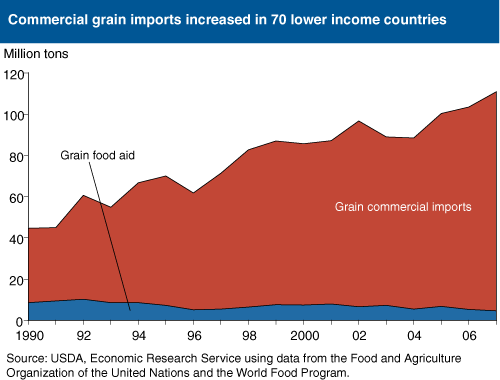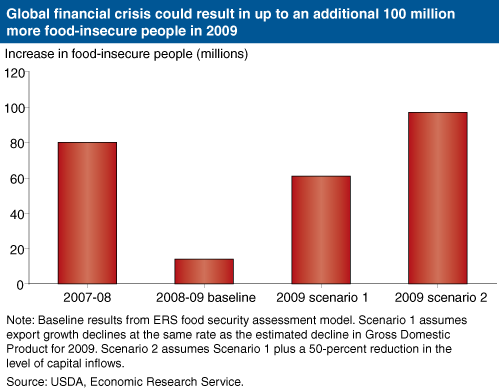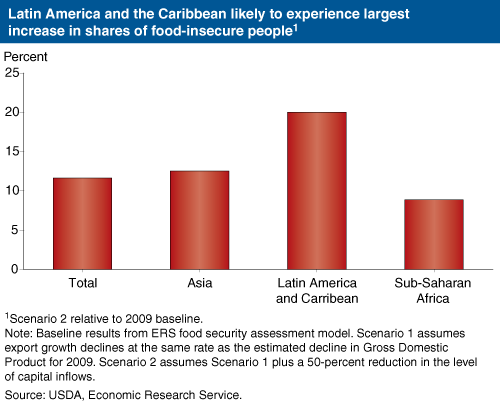Global Economic Crisis Threatens Food Security in Lower Income Countries
- by Stacey Rosen and Shahla Shapouri
- 12/1/2009
Highlights
- The global economic downturn is expected to reduce import capacity in many lower income countries, adversely affecting their food security.
- The number of food-insecure people in the 70 developing countries studied by ERS is estimated to increase 2 percent in 2009, after growing 11 percent in 2008.
- Baseline projections indicate that the number of food-insecure people will remain flat through the next decade, but Sub-Saharan Africa will continue to be the most vulnerable region.
The global economic downturn threatens to shrink import capacity among many lower income countries, with potential food security implications for many of these countries. The economic crisis has led to reduced export earnings as global demand shrank, foreign capital inflows declined, and remittances from relatives working abroad dropped, all of which may constrain the countries’ ability to import needed food.
According to the July 2009 issue of the International Monetary Fund’s (IMF) World Economic Outlook Update, the global recession was not over and economic performance varied widely among regions. Real world gross domestic product (GDP) is expected to contract 1.4 percent in 2009. The IMF stated that declining world food demand and shrinking aid from developed countries, along with continuing fluctuations in commodity prices, will hinder economic recovery in many developing countries.
The difficult financial environment worldwide threatens food security because commercial imports account for a growing share of food supplies in many developing countries. Income growth, trade liberalization policies, improvements in the global transportation system, and, in some cases, an inability to increase domestic production spurred the growth in food imports, including imports of such staples as grains and vegetable oils, which are an important component of diets in most developing countries.
From 1970 to 2003, import dependence grew the most among the least developed countries (LDCs), those with per capita incomes below $750 per year. In 2003, imports accounted for 17 percent of grain consumption in LDCs (compared with 8 percent in 1970), 45 percent of sugar and sweeteners (compared with 18 percent in 1970), and 55 percent of vegetable oils (compared with 9 percent in 1970).
Widespread Food Insecurity in 2008
According to ERS analysis, food insecurity in developing countries worsened between 2007 and 2008 (see box, 'How Food Security Is Assessed'). An estimated 80 million more people—an 11-percent increase—were food insecure in the 70 developing countries studied by ERS in 2008, compared with 2007. In most cases, the deterioration in food security reflected diminished purchasing power of the poor rather than a major shortfall in food production.
The estimated nutritional gap—the amount of food needed to raise consumption at the average national level to the nutritional target of 2,100 calories per person per day—was more than 11 million tons in grain equivalent for 2008. Sub-Saharan Africa, the region most vulnerable to food insecurity, accounted for 55 percent of the gap.
The distribution gap—the amount of food needed to raise consumption in each income group to meet the nutritional target—measures the intensity of global food insecurity. The gap increased by about 25 percent between 2007 and 2008 to more than 24 million tons. Sub-Saharan Africa, with one-quarter of the population of the 70 countries, accounted for 60 percent of the distribution gap. The Asian countries, with 63 percent of the population of the 70 countries, accounted for 32 percent of the distribution gap.
The difference between these two gaps reflects the intensity and depth of the impact of skewed incomes and purchasing power on food security within countries. To put the scale of these gaps in perspective, the amount of food aid from all sources that these countries received in 2008 was approximately 6 million tons.
Financial Crisis Likely Deepened Food Insecurity in 2009
Despite declining food prices in late 2008, deteriorating purchasing power was expected in 2009 because of growing financial deficits and higher inflation in recent years. Using the ERS food security baseline model of 70 lower income countries, ERS researchers estimated a 2-percent increase in the number of food-insecure people in 2009. The estimated growth in the number of food-insecure people will likely be highest in Sub-Saharan Africa because domestic agricultural production was assumed to revert to average levels following above-average production in many countries in 2008. However, if production remains close to the high levels of 2008, the number of food-insecure people would likely be lower than these estimates.
The economic outlook for 2009 has worsened as the year has progressed. In January 2009, the IMF estimated that real world GDP would contract 0.5 percent. By July 2009, the estimated contraction had deepened to 1.4 percent. The actual number of food-insecure people in 2009 will depend on how extensively the global downturn limits import capacity of the lower income countries. Assuming no major domestic production shortfalls, the two critical determinants of food imports and, consequently, food security, will be changes in export earnings and changes in capital inflows (credit, foreign direct investment, financial assistance, and remittances) to finance imports.
Reduced imports will likely have a negligible effect on food security in countries where domestic production accounts for most of the food supplies. However, countries that have become increasingly import dependent could be vulnerable. Import dependency for grain, the main staple food consumed by the poor, is lowest in Asia, followed by Sub-Saharan Africa, the Commonwealth of Independent States, Latin America, the Caribbean, and North Africa.
Most of the Latin American, Caribbean, and North African countries included in the 70 countries in the ERS analysis import nearly half of their grain supplies. Some countries can forgo or reduce imports of other commodities and allocate a much larger share of their import budget to food during a crisis. But for highly food-insecure countries, like many in Sub-Saharan Africa, the decline in economic growth and import capacity can exacerbate food insecurity.
Asian and Latin American Countries Are Hardest Hit
Using IMF projections of changes in countries’ GDP, ERS researchers developed two scenarios in addition to the baseline to evaluate the impact of the global financial crisis on food security in developing countries in 2009. The first scenario assumes that export growth declines at the same rate as the decline in GDP growth estimated for 2009. Economic growth (and, therefore, ERS’s assumption for export growth) was expected to decline 50 percent in North Africa and Sub-Saharan Africa, 60 percent in Latin America, the Caribbean, and the Commonwealth of Independent States, and 40 percent in Asia. For example, an Asian country with an export growth rate of 10 percent for 2009 would see export growth fall to 6 percent.
In addition to the decline in export growth included in the first scenario, a second scenario includes a 50-percent reduction in the level of capital inflows that finance imports in 2009 due to tightening global credit markets. The results of the two scenarios are compared with the 2009 baseline results of the ERS food security assessment model.
Under the first scenario, the reduction in export earnings growth, and the subsequent reduction in import capacity, results in declining food consumption in 2009. The distribution gap increases by 2 percent from the food security baseline and the number of food-insecure people rises by 7 percent, or 61 million, in 2009.
The impact is not uniform across all regions and countries; the results vary depending upon countries’ dependence on food imports and the significance of export earnings in foreign exchange availability. The Asian countries, which have experienced the highest export growth relative to other regions (more than 10 percent per year, on average, since 2000), prove especially vulnerable under this scenario—the number of food-insecure people rises by 11 percent. In Sub-Saharan Africa, a decline in export earnings growth increases the estimated number of food-insecure people by 3 percent.
Under the second scenario, including both reduced capital inflows and declining growth in export earnings, food security deteriorates further. The number of food-insecure people in the 70 countries increases 12 percent, or 97 million, from the baseline for 2009. The scenario has the greatest impact on countries that have recently experienced rapid growth in food imports, depended heavily on remittances, and have few or no safety net programs to mitigate the impacts of these external shocks.
The impact of the second scenario is greatest in Latin America and the Caribbean, where the number of food-insecure people increases an estimated 20 percent from the baseline to 38 percent of the population. This region’s commercial imports have increased steadily as domestic food production has not kept pace with rising food demand. Trade liberalization policies and income growth have been the main forces behind the increase in consumption. High levels of income inequality in the region increase the susceptibility to food insecurity in most Latin American and Caribbean countries.
This region is also vulnerable because of declining remittances—which in many countries exceed the sum of foreign direct investment, official development assistance, and government and private borrowing. Remittances often provide income for the poorest segment of society and are spent on basic necessities like food. Remittances account for about 30 percent of Nicaragua’s GDP and 25 percent of Haiti’s GDP and are likely to decline during this global economic downturn.
Many Asian countries also prove vulnerable to declining capital inflows. The second scenario raises the number of food-insecure people in Asia by 13 percent (or 47 million) from the 2009 baseline. As these countries have increased their share of world trade, they have become increasingly linked to the global economy and are strongly affected by the performance and policies of the major developed countries. The weakening of the global economy directly affects the food security situation of these Asian countries, many of which suffer from persistent extreme poverty.
Potential impacts of reduced capital inflows are greatest in Bangladesh and the Philippines. The second scenario reduces food consumption in Bangladesh so severely that the share of food-insecure people reaches 40 percent of the population in 2009, double the share in the baseline scenario. The number of food-insecure people in the Philippines also doubles under this scenario, to about 20 percent of the population.
Both the Philippines and Bangladesh are taking steps to prevent large increases in food insecurity. The Government of Bangladesh has expanded public distribution of food and increased agricultural input subsidies. The Philippine Government has acted to reduce the impact of higher prices on consumers by providing cash transfers to poor families and targeting rice subsidies to the poor. The Philippine Government also announced a stimulus package in January 2009 aimed at expanding welfare and public works programs.
India has suffered only limited food-security impacts because its cautious financial policies reduced its exposure to external financial shocks. In addition, due to continuing government support for the agricultural sector, the country satisfies its demand for grains largely with domestic production.
In Sub-Saharan Africa, the percentage increase in the number of food-insecure people (9 percent) is smaller, but the absolute increase—36 million people—is the greatest under the second scenario. Sub-Saharan Africa is the world’s most food-insecure region. Average food intake is by far the lowest in the world, barely higher than the daily nutritional target of 2,100 calories per person.
Many countries in Sub-Saharan Africa do not have an adequate supply of food, and the inequality in purchasing power exacerbates the problem. The countries most affected under this scenario are those that have done well economically in recent years—such as Angola, which benefited from high oil prices, and Cape Verde, Cote d’Ivoire, Lesotho, Mauritania, and Senegal, which were financially able to increase their imports. Many Sub-Saharan Africa countries increased food imports because of slow domestic production growth, high population growth (highest relative to other regions), income growth, market liberalization policies, and, more recently, a boost in foreign direct investment. In these countries, domestic food production is slow to respond to the higher global food prices. That, combined with the lack of domestic safety net programs, intensifies vulnerability to food insecurity.
In countries in the Commonwealth of Independent States, the second scenario increases the number of food-insecure people from 2 million to 5 million. Georgia, already one of the most vulnerable countries in the region, will feel the greatest effect—the estimated share of food-insecure people jumps from 20 to 80 percent of the population in the baseline scenario. Imports generally contribute 60 percent of the country’s grain supplies; under the second scenario, reduced financial inflows seriously limit Georgia’s import capacity, threatening its food security.
The full extent of the deterioration in food security in lower income countries in 2009 is still uncertain. However, the two scenarios highlight the vulnerability of millions of poor people whose food consumption is at or near nutritional targets and reveal how critical trade and capital inflows are to food security in many lower income countries with substantial food imports.
Continued Food Insecurity in the Long Term
The near- and medium-term food security of developing countries depends on the depth and the length of the current economic downturn. Tighter credit and weaker global growth are likely to cut into government revenues and investment in areas such as human capital and infrastructure that are essential for sustained growth.
In its July 2009 World Economic Outlook Update, the IMF projects that real world GDP will rise by 2.5 percent in 2010. Even under this assumption, food insecurity in many lower income countries is expected to remain precarious in the longer term. The number of food-insecure people is projected to remain relatively constant through the next decade, equaling 834 million by 2018. However, disaggregated results tell a more complicated story: while an improvement could occur in Asia, deteriorating food security is forecast for Sub-Saharan Africa.
Based on baseline projections, Sub-Saharan Africa will remain the most vulnerable region in 2018, with 25 percent of the population of the 70 lower income countries and 57 percent of the food-insecure people. Several countries, such as Somalia and the Democratic Republic of Congo, are likely to remain politically unstable for several years as they continue to be plagued by armed conflicts. The resulting social dislocation, food insecurity, and famine preclude much optimism in the coming years.
The failure to significantly improve food security in low-income countries raised concerns even before the current global economic downturn. These countries, being poor, have few or no domestic safety net programs in place. The international safety nets that do exist, like food aid, are inadequate for stabilizing food supplies in the more vulnerable countries. Sub-Saharan Africa is the largest recipient of food aid, but this aid amounts to less than a quarter of the region’s estimated food gaps.
Key to any long-term food security solution is boosting agricultural productivity. Agriculture is a major source of employment in many countries and can both alleviate poverty and increase food security. Since 1990, Sub-Saharan Africa has had the highest growth in grain production—2.8 percent per year—among the regions included in this study, but this growth has been almost completely offset by the region’s high population growth of 2.7 percent per year (compared with 0.7 to 1.9 percent in the other regions). In Sub-Saharan Africa, nearly 90 percent of the growth in grain production is attributable to area expansion during the last couple of decades. The region’s grain yields are still about one-third of the world average, indicating great potential for further gains in crop productivity.
The World Bank’s World Development Report 2008: Agriculture for Development emphasizes the need to increase investment in agriculture. The discussion of Africa, both in the short and long term, focused on the need to increase agricultural productivity by improving soil fertility. This would be achieved by increasing fertilizer use in the region, which is currently less than 10 percent of the amount used per unit of land in other developing regions. But sustained agricultural growth—in Sub-Saharan Africa and elsewhere—requires adaptation of new technologies as well as substantial investment in irrigation, rural infrastructure, human capital, and institutions, not just basic inputs.
This article is drawn from:
- Shapouri, S., Rosen, S., Meade, B. & Gale, F. (2009). Food Security Assessment, 2008-09. U.S. Department of Agriculture, Economic Research Service. GFA-20.
You may also like:
- International Food Security. (n.d.). U.S. Department of Agriculture, Economic Research Service.
We’d welcome your feedback!
Would you be willing to answer a few quick questions about your experience?




